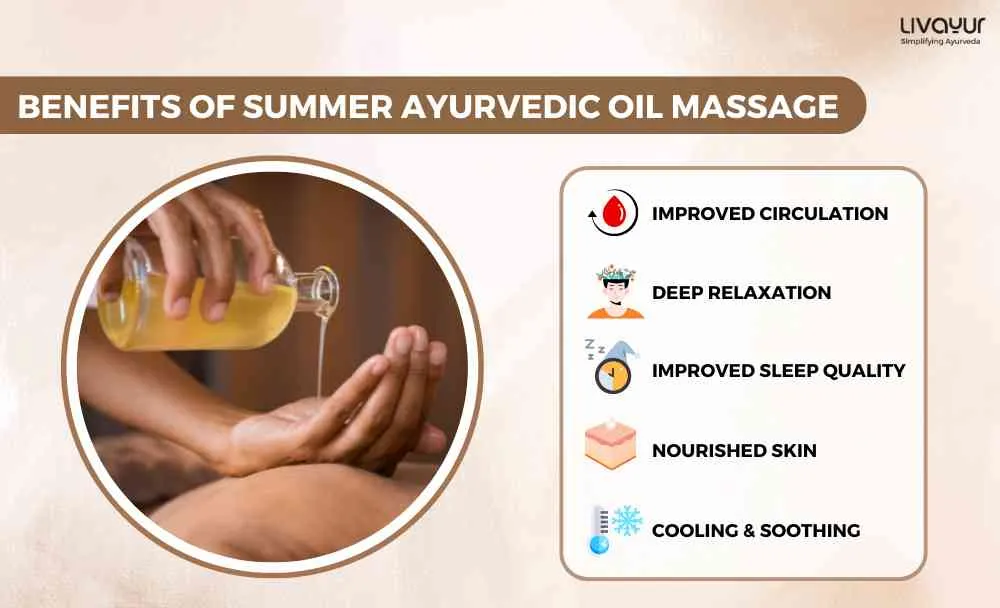
The summer season brings warmth that can be revitalizing, yet excessive heat often leaves us fatigued. Ayurveda, an ancient Indian medicinal system, presents Abhyanga, a practice of self-massage with Ayurvedic oils. This potent yet straightforward method induces bodily relaxation and fosters holistic health, countering the effects of summer lethargy.
The Power of Ayurvedic Oils for Massage
Ayurvedic massage oils are meticulously blended with base oils such as coconut or sesame, enriched with potent herbs to deeply nourish the skin and penetrate tissues, dispersing their therapeutic benefits. They are tailored explicitly for summer, so coconut oil suits all skin types. In contrast, sandalwood oil is renowned for its calming properties, ideal for Pitta dosha. Almond oil, with its light texture, provides gentle yet effective cooling for sensitive skin [1].
Let us quickly look at some of the types of massage oils,
- Sesame oil
- Almond Oil
- Coconut Oil
- Olive Oil
- Bala Ashwagandha
- Avocado Oil
- Castor Oil
- Mahanarayan
- Neem Oil
- Sunflower Oil
Benefits of Ayurvedic Oil Massage in Summer [1]
- Cooling and Soothing: Certain Ayurvedic oils, like coconut or sandalwood, possess natural cooling properties. Massaging with these oils during summer helps regulate body temperature and alleviate the discomfort caused by excessive heat.
- Improved Circulation: Regular Abhyanga stimulates blood flow, promoting the removal of toxins and waste products that can contribute to fatigue. This leaves you feeling energized and revitalized.
- Deep Relaxation: Ayurvedic massage’s gentle, rhythmic strokes promote relaxation and reduce stress, which are common concerns during the summer months. This allows your body and mind to unwind and restore their natural balance.
- Improved Sleep Quality: Stress and fatigue can disrupt sleep patterns. The calming effects of Abhyanga can lead to deeper, more restful sleep, leaving you feeling refreshed and energized in the morning.
- Nourished Skin: Summer heat can take a toll on your skin. Ayurvedic massage oils are rich in antioxidants and nutrients that nourish and protect the skin, leaving it supple and radiant.
The Art of Abhyanga: A Simple Yet Effective Practice
There are various benefits of this ayurvedic massaging method, like,
- Improving skin health by effectively dealing with wrinkles, hyperpigmentation and scars, boosting blood flow, enhancing skin smoothness and softness
- It helps to reduce muscle stiffness and promote flexibility
- Boosts the lymph flow by widening the lymph vessels. This is also known as lymphatic drainage. This is beneficial, especially after surgery around the associated areas.
- It also improves vision, increases physical strength, and resists premature ageing.
Now, let us learn the correct way of carrying out this technique,
- Warm the Oil: Gently warm your chosen Ayurvedic oil to a comfortable temperature.
- Start at Your Feet: Add oil to your feet and slowly work your way up your legs using circular motions.
- Focus on Joints: Pay extra attention to your joints, massaging them gently.
- Upward Strokes for the Torso: Use long, upward strokes to massage your back, chest, and abdomen.
- Head and Scalp: Apply a small amount of oil to your scalp and gently massage in circular motions. Avoid getting oil in your eyes.
- Warm Bath or Shower: After the massage, take a warm bath or shower to remove excess oil.
Conclusion
The benefits of the abhanga massage are numerous. Hence, learning the process of performing this Ayurvedic oiling is necessary. If you are unversed with this ayurvedic massage the guidelines listed above will help you to understand the benefits of ayurvedic massaging as a whole and the process to do so.
FAQs
1. What happens in Abhyanga massage?
The massage is done with warm herbal oils in the direction of arterial movement of the blood to help boost blood flow, flexibility, and physical strength of the body and also act as a stress-buster. Hence, it helps in balancing the different elements of the body to avoid the occurrences of doshas.
2. Who should avoid abhyanga?
Anyone infected with fever, cough and cold, indigestion, high blood pressure, inflammations, bleeding wounds and burns, etc. should avoid this massage. Additionally, this is not recommended for pregnant and menstruating women.
3. Which oil is used for Abhyanga?
Plain untoasted sesame oil is used in this massage. You use either the refined or unrefined version of the oil. Another option in case you cannot avail of sesame oil is coconut oil.

















